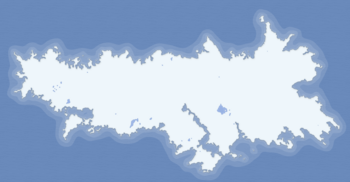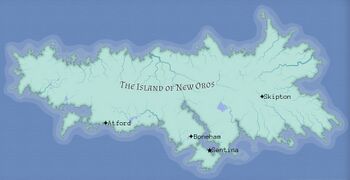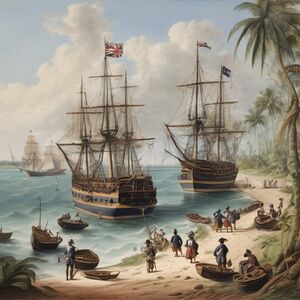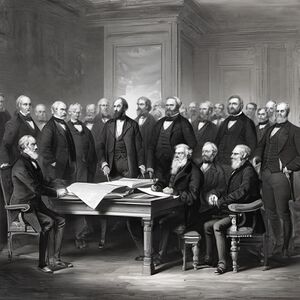New Oros: Difference between revisions
| Line 2: | Line 2: | ||
{{Infobox country | {{Infobox country | ||
<!-- NAMES -->|common_name=New Oros|conventional_long_name=The Island of Oros|image_flag=New Oros Flag.png|alt_flag=Flag|image_coat=Seal of New Oros.png|alt_coat=National Emblem|symbol_type=Seal|national_motto=''Long Live The Island, Long Live New Oros''|image_map=Map of New Oros.png|official_languages=English, Orosian|demonym=New Orosians / Orosians|Judiciary=<!-- HISTORY -->|area=<!--Major area size (in square km)-->|area_magnitude=|area_dabodyalign=<!-- text after area_label2 (optional) -->|currency=Orosian Credit|currency_code=OCD ᛟ|date_format=dd/mm/yyyy|drives_on=Left|iso3166code=OR|footnotes=<!--for any generic non-numbered footnotes-->|footnote1=|footnote2=|map_caption=Map of New Oros|image_map2=citymap.jpg|image_map2_caption=Prominent Cities of New Oros|capital=Sentina|leader_title1=Prime Minister|leader_name1=William Wildman|leader_title2=Defense Minister|leader_name2=Thomas Bright|leader_title3=Foreign Affairs Minister|leader_name3=Julia Smith|leader_title4=Home Affairs Minister|leader_name4=Lowri Tiney|leader_title5=Health Minister|leader_name5=Paul Beesley}} | <!-- NAMES -->|common_name=New Oros|conventional_long_name=The Island of Oros|image_flag=New Oros Flag.png|alt_flag=Flag|image_coat=Seal of New Oros.png|alt_coat=National Emblem|symbol_type=Seal|national_motto=''Long Live The Island, Long Live New Oros''|image_map=Map of New Oros.png|official_languages=English, Orosian|demonym=New Orosians / Orosians|Judiciary=<!-- HISTORY -->|area=<!--Major area size (in square km)-->|area_magnitude=|area_dabodyalign=<!-- text after area_label2 (optional) -->|currency=Orosian Credit|currency_code=OCD ᛟ|date_format=dd/mm/yyyy|drives_on=Left|iso3166code=OR|footnotes=<!--for any generic non-numbered footnotes-->|footnote1=|footnote2=|map_caption=Map of New Oros|image_map2=citymap.jpg|image_map2_caption=Prominent Cities of New Oros|capital=Sentina|leader_title1=Prime Minister|leader_name1=William Wildman|leader_title2=Defense Minister|leader_name2=Thomas Bright|leader_title3=Foreign Affairs Minister|leader_name3=Julia Smith|leader_title4=Home Affairs Minister|leader_name4=Lowri Tiney|leader_title5=Health Minister|leader_name5=Paul Beesley}} | ||
The '''Island of New Oros''', commonly referred to as '''New Oros''' (new·o·ros; pronounced nyew-oh-ros), is an island nation on [[Eurth]]. New Oros has a population of approximately 14 million, and an area of 616,103 km<sup>2</sup> (237,879 sq mi). The government is situated in the capital city of Sentina where the nations leaders meet everyday. | The '''Island of New Oros''', commonly referred to as '''New Oros''' (new·o·ros; pronounced nyew-oh-ros), is an island nation on [[Eurth]]. New Oros has a population of approximately 14 million, and an area of 616,103 km<sup>2</sup> (237,879 sq mi). The government is situated in the capital city of Sentina where the nations leaders meet everyday. The national animal is the [[Feather-Bellied Orosian Coati]]. This is extremely significant due to the scientific efforts by generic modification the [[Feather-Bellied Orosian Coati]] was able to be brought back to life. | ||
== Geography == | == Geography == | ||
Revision as of 15:00, 12 April 2024
Introduction
The Island of Oros | |
|---|---|
Motto: Long Live The Island, Long Live New Oros | |
 Map of New Oros | |
 Prominent Cities of New Oros | |
| Capital | Sentina |
| Official languages | English, Orosian |
| Demonym(s) | New Orosians / Orosians |
| Government | |
• Prime Minister | William Wildman |
• Defense Minister | Thomas Bright |
• Foreign Affairs Minister | Julia Smith |
• Home Affairs Minister | Lowri Tiney |
• Health Minister | Paul Beesley |
| Currency | Orosian Credit (OCD ᛟ) |
| Date format | dd/mm/yyyy |
| Driving side | left |
The Island of New Oros, commonly referred to as New Oros (new·o·ros; pronounced nyew-oh-ros), is an island nation on Eurth. New Oros has a population of approximately 14 million, and an area of 616,103 km2 (237,879 sq mi). The government is situated in the capital city of Sentina where the nations leaders meet everyday. The national animal is the Feather-Bellied Orosian Coati. This is extremely significant due to the scientific efforts by generic modification the Feather-Bellied Orosian Coati was able to be brought back to life.
Geography
Coastal Regions:
In certain regions along the coastline, rugged cliffs and rocky outcrops dominate the landscape. These areas are often carved by the relentless force of the sea, creating dramatic formations and scenic vistas. New Oros is also home to numerous sandy beaches, stretching along the coastline for miles. These pristine beaches offer opportunities for sunbathing, swimming, and beachcombing, attracting locals and tourists alike. Nestled between rocky headlands, coastal coves dot the shoreline of New Oros. These sheltered alcoves provide tranquil settings for relaxation and recreation, with calm waters ideal for snorkeling, kayaking, and exploring marine life. Estuarine ecosystems thrive along certain stretches of the coastline, where rivers meet the sea. Mangrove forests fringe these estuaries, serving as vital habitats for a diverse array of plant and animal species, including migratory birds and juvenile fish. Perched atop cliffs overlooking the sea, quaint villages and towns offer panoramic views of the coastline. These charming settlements boast a maritime heritage, with fishing and maritime activities playing a central role in local life. Throughout the coastline, historic lighthouses stand as sentinel guardians, guiding ships safely through treacherous waters. These iconic structures are emblematic of New Oros's maritime heritage and serve as landmarks of navigation and maritime history. Recognizing the ecological significance of its coastline, New Oros has designated several coastal conservation areas and marine reserves. These protected areas safeguard fragile ecosystems, biodiversity hotspots, and important breeding grounds for marine species.
Mountainous Interior:
The Cerynian Mountains are situated centrally on the island, occupying a significant portion of New Oros's interior. Rather than extending as a continuous spine, they form a concentrated massif, with peaks rising prominently above the surrounding landscape. These mountains are characterized by their rugged terrain, with steep slopes, deep valleys, and imposing peaks defining the landscape. The centralization of the range creates a dramatic and imposing presence, with towering summits and sheer cliffs contributing to its awe-inspiring beauty. Despite their centralized location, the Cerynian Mountains boast remarkable biodiversity, supporting a wide range of plant and animal species adapted to mountainous environments. From dense forests blanketing lower slopes to alpine meadows and rocky crags at higher elevations, the range harbors diverse ecosystems and habitats. The Cerynian Mountains play a crucial role in regulating New Oros's climate and hydrology. They serve as a natural barrier, intercepting moisture-laden winds and influencing precipitation patterns across the island. Additionally, the mountains act as a watershed, feeding rivers and streams that provide freshwater resources for both human consumption and ecological processes. The Cerynian Mountains hold deep cultural significance for the people of New Oros, serving as a symbol of strength, resilience, and spiritual connection to the land. Ancient myths, legends, and traditions are intertwined with the rugged landscapes and hidden valleys of the mountain range, enriching the island's cultural heritage. The Cerynian Mountains offer abundant opportunities for outdoor recreation and adventure. Hiking trails wind through forests and alpine meadows, providing access to panoramic viewpoints and hidden valleys. Rock climbing, mountaineering, and wildlife watching are popular activities, attracting adventurers and nature enthusiasts to the rugged terrain of the range. Recognizing the ecological importance of the Cerynian Mountains, conservation initiatives are in place to protect and preserve this vital ecosystem. National parks, protected areas, and conservation zones have been established to safeguard biodiversity, conserve habitats, and promote sustainable land management practices.
Valleys and Plains:
Nestled between the towering peaks of the Cerynian Mountains, New Oros is graced with picturesque valleys that offer a stark contrast to the rugged terrain of the surrounding mountains. These valleys are characterized by their lush greenery, fertile soils, and meandering rivers, creating idyllic landscapes that are rich in biodiversity and natural beauty. The valleys of New Oros hold cultural significance for the island's inhabitants, serving as centers of agriculture, settlement, and community life. Villages and towns dot the valley floors, with terraced fields, orchards, and vineyards extending across the fertile plains. Ancient traditions, folklore, and festivals are deeply rooted in the agrarian lifestyle of valley communities, enriching the cultural tapestry of the island. The scenic beauty and tranquility of New Oros's valleys make them popular destinations for outdoor recreation and tourism. Hiking trails wind through the verdant landscapes, offering breathtaking views of the surrounding mountains and valleys. Visitors can explore quaint villages, sample local cuisine, and experience the hospitality of valley communities, immersing themselves in the charm and authenticity of rural life.
In addition to its mountainous terrain and fertile valleys, New Oros is also home to expansive grasslands and plains that stretch across the island's interior. These vast open spaces are characterized by rolling hills, sweeping vistas, and a patchwork of grassy meadows, providing habitat for a variety of plant and animal species adapted to open landscapes. Despite their seemingly barren appearance, the plains of New Oros support a rich diversity of wildlife, including grazing mammals, birds of prey, and small mammals. Endemic species, such as the New Orosian wild horse, roam the grasslands, while migratory birds flock to the region during seasonal migrations. The plains of New Oros are also an important agricultural heartland, with vast expanses of arable land cultivated for crops such as wheat, barley, and maize. Farms and ranches dot the landscape, contributing to the island's food security and economic prosperity. Traditional farming practices coexist with modern agricultural methods, preserving the rural character and cultural heritage of the plains. While the plains of New Oros offer valuable resources and habitat for wildlife, they also face conservation challenges, including habitat loss, fragmentation, and degradation due to agricultural expansion and urban development. Efforts to balance conservation and sustainable land use are underway, with initiatives aimed at protecting critical habitats, restoring degraded landscapes, and promoting biodiversity conservation across the plains.
Rivers and Lakes:
New Oros is blessed with a network of rivers that crisscross the landscape, flowing from the mountains to the sea. These majestic waterways are lifelines for the island, providing freshwater resources for drinking, irrigation, and industry, while also serving as vital habitats for aquatic species. The rivers of New Oros exhibit diverse characteristics, ranging from swift mountain streams to meandering lowland rivers. Fed by snowmelt and rainfall from the Cerynian Mountains, these waterways traverse a variety of landscapes, including dense forests, fertile valleys, and expansive grasslands, before reaching the coast. The rivers of New Oros support rich and diverse ecosystems, with riparian habitats providing critical habitat for a variety of plant and animal species. Fish, amphibians, and aquatic birds thrive in the riverine environment, while wetlands and marshes along the banks provide breeding grounds and feeding areas for migratory species. The rivers of New Oros hold cultural significance for the island's inhabitants, serving as sources of inspiration, sustenance, and spiritual connection to the land. Ancient myths, legends, and traditions are intertwined with the flow of the rivers, shaping the cultural identity and heritage of the island's people.
Scattered throughout the landscape, New Oros is dotted with tranquil lakes and reservoirs that provide havens of serenity and natural beauty. These bodies of water range in size and character, from small mountain tarns nestled in alpine valleys to expansive reservoirs formed by dams on major rivers. The lakes of New Oros offer abundant opportunities for outdoor recreation and leisure activities. Fishing, boating, and water sports are popular pastimes, with anglers casting their lines for trout, bass, and other freshwater species, while boaters and kayakers explore the scenic shores and hidden coves of the lakes. Lakes and reservoirs provide important habitats for a variety of aquatic and semi-aquatic species, including fish, waterfowl, and wetland birds. Marshes, reed beds, and submerged vegetation offer nesting sites, feeding grounds, and shelter for a diverse array of wildlife, contributing to the ecological richness and biodiversity of the region. In addition to their recreational and ecological value, lakes and reservoirs play a crucial role in water management and irrigation in New Oros. Reservoirs regulate the flow of rivers, store water for agricultural and municipal use, and provide flood control during periods of high rainfall, ensuring the sustainable management of water resources across the island.
History
Ancient Oros
Tribal Conflicts
Ancient Orosians were masters at painting and petroglyphs, because of this much of their history was able to be discovered. This oldest dated petroglyph was found in a temple in the Cerynian Mountains which scientists using cardiocarbon dating was over 2,420 years old. In the era around 400 BCE, the island of New Oros was a land of rugged beauty and untamed wilderness, inhabited by several distinct tribal groups vying for dominance and territorial control. Among these tribes, three prominent factions emerged as key players in the tumultuous landscape of ancient New Oros: The Cerynian Tribe in the east, The Orosan Tribe in the south, and The Gwentish Tribe in the west.
To the east of New Oros lay the vast and formidable territory of The Cerynian Tribe, a coalition of clans known for their martial prowess and fierce independence. Led by chieftains who claimed descent from legendary warriors of old, the Cerynians were renowned for their expertise in warfare and their mastery of the island's rugged terrain. Their domain encompassed sprawling forests, craggy mountains, and fertile valleys, providing ample resources to sustain their burgeoning population. The Cerynian Tribe would often wear white clothing in day to day life and in battle.
In the southern reaches of the island, The Orosan Tribe held sway over a vast expanse of territory, stretching from the sun-drenched shores of the coast to the verdant plains of the interior. Governed by a council of elders and shamans, the Orosans were known for their agricultural prowess, skilled craftsmanship, and sophisticated cultural traditions. However, their hegemony was often challenged by rival tribes seeking to assert their own claims to power. The Orosan Tribe would often wear golden yellow clothes.
To the west, across rugged highlands and rushing rivers, lay the domain of The Gwentish Tribe, a confederation of fiercely independent clans united by a common heritage and a shared sense of identity. Resilient and resourceful, the Gwentish warriors were renowned for their prowess in battle and their unwavering commitment to their ancestral lands. Despite their decentralized structure, The Gwentish Tribe posed a formidable challenge to any who dared to encroach upon their territory. The Gwentish Tribe would often wear red clothing.
Tribal Rivalries and Conflicts
Throughout this period, the tribes of ancient New Oros were locked in a perpetual struggle for supremacy, with shifting alliances, territorial disputes, and skirmishes erupting sporadically across the island. The Cerynian Tribe clashed with The Orosan Tribe over control of strategic trade routes and fertile farmlands, while The Gwentish Tribe waged guerrilla warfare against both factions in a bid to safeguard their ancestral territories.
Legacy and Remembrance
The era of tribal conflicts in ancient New Oros left a lasting legacy on the island's history and culture, shaping the identities of future generations and leaving behind tales of valor, betrayal, and resilience. Today, the descendants of the Cerynian, Orosan, and Gwentish Tribes continue to honor the memory of their ancestors, preserving their traditions and heritage as a testament to the enduring spirit of ancient New Oros.
Discovery and Colonisation (16th - 18th Century)
New Oros, nestled on the 35th latitude in the northern hemisphere, was first discovered by British explorers in the 16th century during the Age of Discovery. This period marked a significant era of maritime exploration, with European powers venturing into uncharted waters in search of new trade routes, territories, and riches.
The British, renowned for their seafaring prowess and maritime ambitions, set sail across the vast expanse of the Atlantic Ocean, driven by a fervent desire to expand their global influence and economic dominance. Led by intrepid navigators and explorers such as Sir Francis Drake, Sir Walter Raleigh, and Captain James Cook, British expeditions charted new courses and mapped distant lands, hoping to unlock the secrets of the world's oceans and uncover untold treasures.
It was during one of these daring voyages that British sailors stumbled upon the lush and verdant island of New Oros. Attracted by its favorable climate, fertile soil, and strategic location along key trade routes, the British recognized the potential of the island as a valuable asset in their burgeoning empire. They wasted no time in staking their claim to the land, hoisting the Union Jack and declaring it a possession of the British Crown.
Establishing colonies on the island, the British brought with them a diverse array of settlers, including adventurers, merchants, farmers, and missionaries, each seeking their fortune and opportunity in the new world. They erected trading posts, forts, and settlements along the coastline, laying the foundations for a burgeoning colonial society.
However, the arrival of the British colonizers also brought significant upheaval and displacement to the indigenous peoples of New Oros. The native tribes, accustomed to their traditional way of life and fiercely protective of their ancestral lands, found themselves increasingly marginalized and subjugated under British rule. Conflict and resistance flared as tensions mounted between the indigenous populations and the encroaching colonizers, leading to a protracted struggle for control and sovereignty over the island.
Despite the challenges and hardships faced by both settlers and natives, the colonial period witnessed the rapid growth and development of New Oros. British influence brought advancements in agriculture, technology, and governance to the island, transforming it into a bustling hub of trade, commerce, and cultural exchange. The legacy of British colonization left an indelible mark on the identity and trajectory of New Oros, shaping its history, culture, and destiny for centuries to come.
Colonial Period (18th - 19th Century):
Over the next centuries, New Oros evolved into a prized possession for the British Empire, serving as a vital outpost in the expansive colonial network that spanned the globe. The island's strategic location along key trade routes and its abundance of natural resources made it a coveted asset for British imperial ambitions.
Establishment of Colonial Rule: With the establishment of colonial rule, the British exerted their authority over New Oros, imposing a system of governance that favored their interests and objectives. Colonial administrators, appointed by the British Crown, wielded significant power and influence, overseeing the administration of the island and enacting policies designed to maximize economic exploitation and control.
Exploitation and Reshaping of Society: The British colonial administration exploited the natural riches of New Oros, harnessing its fertile soil, lush forests, and mineral deposits for the benefit of the empire. Plantations were established to cultivate cash crops such as sugarcane, tobacco, and cotton, using forced labor systems such as indentured servitude and later, slavery, to fuel the production process.
Impact on Indigenous Population: The imposition of colonial rule had profound implications for the indigenous population of New Oros. Native tribes, accustomed to their traditional way of life and communal governance structures, found themselves marginalized and disenfranchised under British colonialism. Their lands were seized, their cultural practices suppressed, and their autonomy eroded as colonial authorities asserted control over every aspect of their lives.
Cultural Assimilation and Resistance: Despite the efforts of the British to impose cultural assimilation upon the indigenous population, elements of native traditions persisted and adapted in the face of colonial domination. Indigenous languages, rituals, and customs endured, often blending with British influences to create a unique syncretic culture that reflected the complex interplay between colonialism and resistance.
Emergence of Colonial Society: A new colonial society emerged on New Oros, characterized by social stratification, racial hierarchies, and cultural hybridity. British settlers, administrators, and merchants formed the elite ruling class, enjoying privileges and opportunities denied to the indigenous population. Meanwhile, native tribespeople, relegated to the margins of society, struggled to preserve their cultural identity and assert their rights in the face of systemic oppression.
Legacy of Colonialism: The legacy of British colonialism left an indelible mark on the history and identity of New Oros. While it brought advancements in infrastructure, technology, and governance, it also perpetuated inequalities, injustices, and divisions that continue to reverberate in the present day. The scars of colonialism serve as a reminder of the resilience and resistance of the indigenous peoples of New Oros, who continue to strive for recognition, restitution, and reconciliation in the aftermath of centuries of exploitation and subjugation.
Renaming to New Oros and Struggle for Independence (Late 19th - Early 20th Century):
As nationalist fervor swept across the globe in the 19th and early 20th centuries, the aspirations for independence took root among the people of Oros. Inspired by the ideals of self-determination and sovereignty, indigenous leaders, intellectuals, and activists began to galvanize support for liberation from British colonial rule. The struggle for independence became a defining moment in the history of New Oros, marked by protests, uprisings, and political mobilization against the entrenched power of colonial authorities.
Emergence of Indigenous Leadership: Amidst growing discontent with colonial rule, indigenous leaders emerged as champions of the independence movement in New Oros. Visionaries such as William Sykes rallied their fellow countrymen with impassioned speeches, calls to action, and strategies for resistance against colonial oppression. These leaders became symbols of hope and inspiration, uniting disparate factions and tribes under a common goal of freedom and self-governance.
Protests and Uprisings: The struggle for independence in New Oros was characterized by a series of protests, demonstrations, and acts of civil disobedience aimed at challenging the authority of the colonial regime. From peaceful marches to boycotts of British goods to outright acts of rebellion, the people of New Oros refused to accept the status quo and demanded their right to determine their own destiny.
Political Mobilization and Organization: Political parties, liberation movements, and underground networks flourished in New Oros during this period, providing a platform for dissent and collective action against colonial rule. These organizations played a crucial role in mobilizing support, disseminating propaganda, and coordinating resistance efforts across the island. They operated clandestinely, evading colonial surveillance and repression, while advocating for the rights and aspirations of the indigenous population.
Renaming to New Oros: Amidst the fervor for independence and the growing momentum of the nationalist movement, the people of Oros sought to assert their newfound identity and break free from the shackles of colonialism. In a symbolic gesture of defiance and renewal, the island was officially renamed New Oros, signaling a fresh chapter in its history and a rejection of its colonial past. The name change symbolized the collective aspirations of the people for freedom, dignity, and self-determination, as they embarked on the journey towards nationhood and independence.
Path to Independence: The struggle for independence in New Oros was a protracted and arduous journey, marked by sacrifice, perseverance, and resilience. Despite facing formidable challenges and setbacks, including violent repression by colonial authorities, the people of New Oros remained steadfast in their pursuit of freedom and justice. Finally, in 1950, after decades of resistance and agitation, New Oros achieved independence from British colonial rule, ushering in a new era of sovereignty and self-governance for the island nation.
Civil War and Independence (Mid-20th Century):
The quest for independence in New Oros was fraught with challenges and complexities, as internal divisions and external interference threatened to derail the aspirations of the island's people for self-rule. A bitter civil war erupted, tearing at the fabric of society and plunging New Oros into a period of turmoil and upheaval.
Roots of Conflict: The seeds of the civil war in New Oros were sown deep within the socio-political landscape of the island. Ideological differences, ethnic tensions, and geopolitical rivalries simmered beneath the surface, exacerbated by decades of colonial oppression and exploitation. As the nationalist movement gained momentum, competing factions emerged, each vying for control of the island's destiny and the future of its people.
Factions and Alliances: The civil war in New Oros saw the emergence of several rival factions, each with its own vision for the future of the island. Indigenous liberation movements, ethnic militias, and political parties clashed in a bid for supremacy, drawing support from external powers with vested interests in the region. Allegiances shifted and alliances formed and dissolved as the conflict escalated, adding further complexity to an already volatile situation.
Bloodshed and Devastation: The civil war brought untold suffering to the people of New Oros, as violence ravaged communities, cities, and countryside alike. Battles raged across the island, with casualties mounting on both sides of the conflict. Civilians bore the brunt of the fighting, enduring displacement, hunger, and atrocities perpetrated by warring factions. The once-thriving economy of New Oros lay in ruins, its infrastructure shattered, and its social fabric torn asunder by the ravages of war.
External Intervention: The civil war in New Oros drew the attention of external powers, eager to assert their influence and further their own geopolitical agendas in the region. Foreign governments provided military aid, funding, and logistical support to various factions, exacerbating the conflict and prolonging the suffering of the island's people. Proxy battles and covert operations played out on New Orosian soil, turning the island into a battleground for rival powers jockeying for supremacy.
Quest for Self-Rule: Amidst the chaos and carnage of civil war, the desire for self-rule and independence remained a beacon of hope for the people of New Oros. Despite the immense challenges and obstacles they faced, the resilience and determination of the island's inhabitants never wavered. Grassroots movements, community leaders, and ordinary citizens rallied together in a common cause, united by their shared aspiration for freedom, dignity, and sovereignty.
Emergence of an Independent New Oros: After years of bloodshed and sacrifice, the civil war in New Oros finally reached its conclusion. Through perseverance, negotiation, and compromise, a path to peace and reconciliation emerged, paving the way for the establishment of an independent New Oros. In 1962, the leaders of rival factions came together to sign a historic peace agreement, marking the end of hostilities and the dawn of a new era for the island nation.
Reconstruction and Reconciliation: The end of the civil war ushered in a period of reconstruction and reconciliation in New Oros. Efforts were made to heal the wounds of war, rebuild shattered communities, and foster a sense of national unity and identity among New Orosians. Truth and reconciliation commissions were established to address past injustices and atrocities, while measures were put in place to promote inclusivity, democracy, and respect for human rights.
Legacy and Lessons Learned: The civil war in New Oros left a lasting legacy on the island and its people, serving as a sobering reminder of the devastating consequences of conflict and division. The scars of war may never fully heal, but they serve as a testament to the resilience, courage, and spirit of endurance of the New Orosian people. The experience of civil war has shaped the collective memory and consciousness of the nation, instilling a commitment to peace, democracy, and social justice for generations to come.
Post-Independence Era (Late 20th Century - Present):
Following independence, New Oros embarked on a transformative journey of nation-building, reconciliation, and progress. Liberated from the shackles of colonialism, the island nation set out to forge its own path, guided by the principles of democracy, equality, and self-determination.
Democratic Consolidation: In the aftermath of independence, New Oros prioritized the establishment and consolidation of democratic institutions as the cornerstone of its fledgling democracy. Free and fair elections were held, and democratic governance structures were put in place to ensure the participation of all citizens in the decision-making process. Political pluralism flourished, with multiple parties representing diverse interests and ideologies vying for power through peaceful means.
Reconciliation and Healing: Central to New Oros's post-independence agenda was the imperative of reconciliation and healing in the wake of the civil war. Truth and reconciliation commissions were established to uncover the atrocities of the past, promote accountability, and facilitate national healing. Initiatives aimed at fostering inter-ethnic harmony, dialogue, and understanding were implemented, fostering a culture of tolerance, acceptance, and mutual respect among New Orosians.
Economic Development and Social Cohesion: New Oros faced formidable challenges in the realms of economic development and social cohesion in the post-independence era. The scars of war, coupled with the legacies of colonial exploitation and underdevelopment, posed significant hurdles to progress. However, through prudent economic policies, investment in infrastructure, and the promotion of inclusive growth strategies, New Oros made strides towards achieving economic prosperity and social equity. Efforts to address poverty, inequality, and unemployment were prioritized, with a focus on empowering marginalized communities and fostering sustainable development across the island.
Cultural Renaissance and National Identity: The post-independence era witnessed a vibrant cultural renaissance in New Oros, as the island nation celebrated its rich heritage and diverse cultural traditions. Indigenous languages, arts, and customs were revitalized and promoted, fostering a sense of pride and belonging among New Orosians. Cultural festivals, music, and literature flourished, serving as expressions of the nation's identity and resilience in the face of adversity.
Global Engagement and Regional Cooperation: As a sovereign and independent nation, New Oros actively engaged with the international community and sought to strengthen its ties with neighboring countries and regional organizations. Diplomatic initiatives aimed at promoting peace, stability, and cooperation in the region were pursued, with New Oros playing a constructive role in regional forums and multilateral initiatives. Bilateral trade agreements, investment partnerships, and cultural exchanges further deepened New Oros's integration into the global community.
Looking to the Future: Today, New Oros stands as a beacon of hope and progress in the region, proud of its achievements and optimistic about its future. While the legacy of British colonialism continues to cast a long shadow over its society and institutions, New Oros remains resolute in its determination to overcome past injustices and build a better tomorrow for all its citizens. Embracing the opportunities and challenges that lie ahead, New Oros looks to the future with optimism and confidence, guided by the principles of democracy, inclusivity, and human rights that have defined its journey towards independence.















